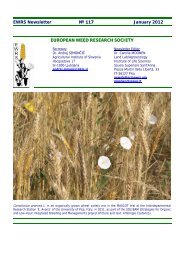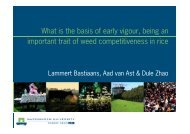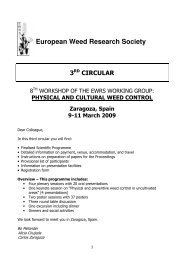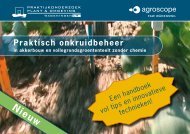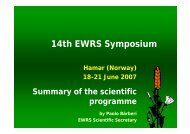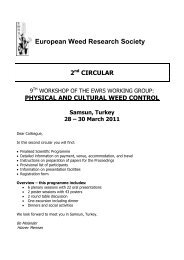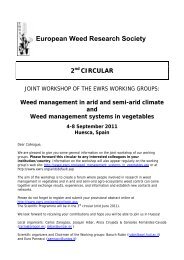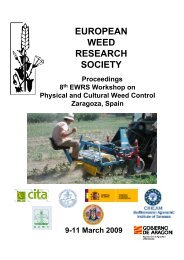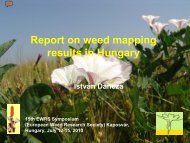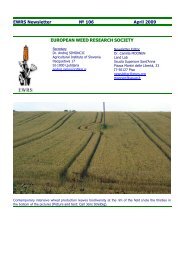Physical and Cultural Weed Control Working Group of - European ...
Physical and Cultural Weed Control Working Group of - European ...
Physical and Cultural Weed Control Working Group of - European ...
You also want an ePaper? Increase the reach of your titles
YUMPU automatically turns print PDFs into web optimized ePapers that Google loves.
9 th EWRS Workshop on <strong>Physical</strong> <strong>and</strong> <strong>Cultural</strong> <strong>Weed</strong> <strong>Control</strong> 49<br />
Samsun, Turkey, 28 – 30 March 2011<br />
Impacts <strong>of</strong> different crop management systems on arable weed flora<br />
D. Piliksere, L. Zarina<br />
State Priekuli Plant Breeding Institute, 1a Zinatnes iela, Priekuli, LV 4126, Latvia Email:<br />
dacepil@gmail.com<br />
Although weed issue arose already along with the dawn <strong>of</strong> agriculture, there still is not enough<br />
knowledge on weed biological <strong>and</strong> ecological nature, to solve the weed problem. The aim <strong>of</strong> our<br />
study was to establish the role <strong>of</strong> different crop growing practices in influencing arable weed flora,<br />
to provide new knowledge for environmentally friendly crop management systems. The early<br />
summer arable weed data were collected from long-term investigation field at State Priekuli Plant<br />
Breeding Institute (57˚19΄ N, 25˚20΄ E). Investigation field consisted <strong>of</strong> five different crop rotations<br />
that were established in six different fertilization systems. Crop rotations were: 1) summer cereals<br />
(barley or oat) – potatoes – summer cereals; 2) summer cereals – perennial grasses – winter cereals<br />
(rye or wheat) – potatoes; 3) summer cereals – perennial grasses – summer cereals – winter cereals<br />
– summer cereals – potatoes; 4) summer cereals – perennial grasses – potatoes; 5) summer cereals –<br />
perennial grasses – perennial grasses – winter cereals – summer cereals – potatoes. Fertilization<br />
systems were: 1) unfertilized; 2) animal manure (20 t ha -1 ); 3) N66P90K135; 4) animal manure +<br />
N66P90K135; 5) N132P180K270; 6) straw + N66P90K135. In total 44 different weed taxa (at species or<br />
family level) were found in 22-year period between 1973 <strong>and</strong> 2009. Data were analyzed using<br />
descriptive statistics, general linear model (GLM) <strong>and</strong> canonical correspondence analysis (CCA).<br />
Six GLMs were created - three for both weed density (plant m -2 ), <strong>and</strong> weed species diversity, for<br />
annual, perennial <strong>and</strong> total weed accordingly. The CCA model included 31 weed taxa, which<br />
incidence was more than five percent. Fertilization system more affected annual weed densities <strong>and</strong><br />
species composition, while crop rotation had significant impacts on perennial weed densities. Some<br />
weed taxa were found that had an indicator value for identifying the impact <strong>of</strong> particular crop<br />
rotation or fertilization system. Results can be applied to other areas, which have similar soils <strong>and</strong><br />
climate conditions as they are at investigation in Priekuli.



